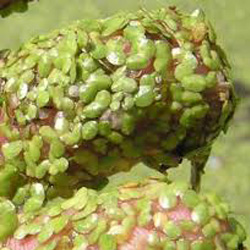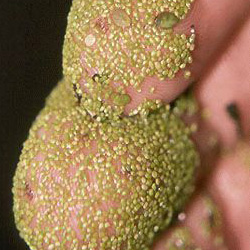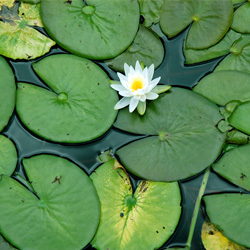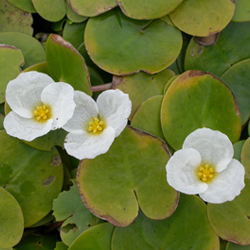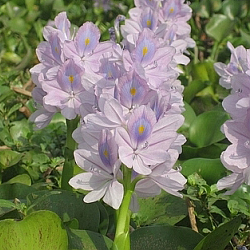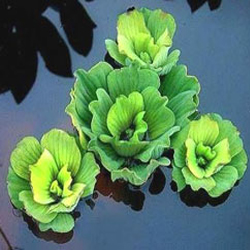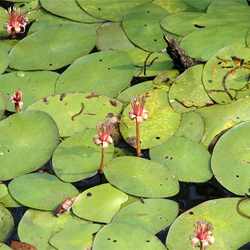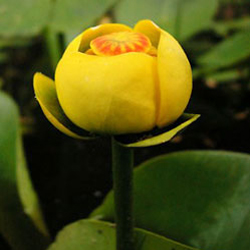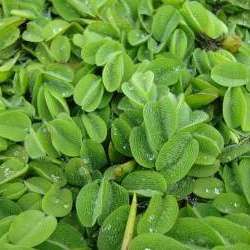Floating Weeds
Duckweed
Duckweed has small, single or grouped, clover-like floating leaves, with a root that hangs from the underside of the plant. Duckweed and watermeal are the smallest aquatic plants known. Duckweed reproduces by budding and fragmentation. These minute plants serve as food for numerous organisms, especially for waterfowl. While these plants are small, they can reproduce prolifically and completely cover a pond surface when growing conditions are right. A duckweed infestation can block sunlight from reaching deeper parts of the pond, preventing underwater plants from photosynthesizing and producing oxygen. In turn, that lack of oxygen can stress or kill fish.
Watermeal
Watermeal can be easily identified by its small, single, oval-shaped leaf. It has the appearance of grass seed floating on the surface of the pond and is typically found along with duckweed The leaf of watermeal ranges from 0.2 to 1.5 millimeters in length, about the size of a pin-head, which is much smaller than Duckweed. Watermeal and duckweed are the smallest known aquatic plants. Watermeal reproduces by budding and fragmentation and can be an aggressive invader making ponds unsightly and unusable. These tiny plants can be more than an eyesore; heavy amounts of growth can prevent sunlight from reaching deeper parts of the pond, preventing underwater plants from photosynthesizing and producing oxygen. Like duckweed, this lack of oxygen can cause a fish kill.
Lily Pads
Lily pads are known for their broad, green leaves, and white and yellow flowers that bloom throughout the summer and add charm and beauty to many ponds and lakes. White water lilies have round leaves that look like floating plates, while yellow water lilies have heart-shaped leaves that stand tall above the water and flutter in the breeze. In addition to their natural beauty, lily pads provide a host of benefits to lake ecology. Aquatic insects are attracted to the flowers and rest on their leaves and stems. Frogs and turtles seek the camouflage lily pads offer from predators. Fish hide among the stems, not only from each other, but also from the sun. Lily pads grow in shallow water and buffer waves, protecting the shore from erosion. Despite these benefits, sometimes it is necessary to control their expansion to avoid lily pads from impairing lake access, and recreational activities. They can also cover the surface in just a few weeks reducing light penetration resulting in decline of fish, invertebrates and aquatic plants.
European Frog-Bit
European frog-bit is an invasive aquatic plant that grows rapidly and forms dense, floating mats. It can be found in slow-moving waters such as sheltered inlets, ponds and slow-running rivers and ditches. European frog-bit can free-float, or extend its roots up to 20 inches long in shallow water. It produces a single two-inch wide white flower with three rounded petals and a yellow center. Its leaves are about one inch wide, heart-shaped with purple–red bottoms and a spongy coating along the middle vein. These fast-growing plants form thick mats that reduce biodiversity by crowding out native plants and preventing sunlight from reaching submerged plants. When a large colony of the plant dies and decomposes it removes oxygen from the water, which can affect fish communities and other aquatic life. Dense masses of European frog-bit can hinder swimmers and boaters, prevent other recreational uses of waterways, and clog drainage canals and streams.
Water Hyacinth
Sometimes referred to as the “weed from hell”, water hyacinth is a free-floating plant with an explosive growth rate. At its worst, it can form impenetrable mats, boost mosquito numbers, and deplete the water of dissolved oxygen, effectively suffocating fish. It also hinders recreational activities and clogs up drainage canals and streams. Water hyacinth has ovate leaves, 4-8 inches in diameter. The leaf stalks can be up to 20 inches long and are spongy with bulbous, inflated bases. Its bluish flowers are showy with 8-15 flowers on a single plant and each plant can produce up to 3000 seeds.
Water Lettuce
This mildly toxic pondweed can cause mouth irritation, nausea, vomiting and diarrhea if ingested. Water lettuce roots are submerged, extremely feathery, and grow up to 3 feet in length. Leaves grow in lettuce-like rosettes up to 6 inches in diameter and are distinguished by their wavy edges and ridges and veins. They are thick, light to lime green, and have velvet-like hairs. The fruits of water lettuce are small, green berries, and contain many seeds. Water lettuce prefers stagnant or slow moving freshwater environments. It can, however, grow in very moist soil. Extensive mats of water lettuce on the water surface reduce light penetration and dissolved oxygen levels in the water, altering native aquatic plant and fish communities and causing a loss of biodiversity. Water lettuce mats also impede boat traffic and clog irrigation canals. Stagnant water created by water lettuce population can also serve as breeding ground for mosquitoes.
Water Shield
Water shield is a native, floating-leaf plant with moderately sized football shaped leaves. The tops of the leaves are leathery and green during the growing season, changing to brilliant yellow, orange and red in the fall. The stems are attached to the center of the leaves and have a clear, gelatinous coating on the stems and underside of each leaf. The flowers are maroon to purple, less than two inches wide and produced on stems that emerge just above the water surface from buried rhizomes. Water shield thrives in shallow, slow moving waters with nutrient-rich sediment. Water shield provides shade and cover for fish and a habitat for frogs and other invertebrates. A number of animals, including ducks, feed on water shield. Despite these benefits, it is sometimes necessary to control their expansion to avoid mats from becoming a nuisance and impairing lake access and recreational activities.
Spatterdock
Spatterdock is a native, perennial, aquatic wildflower that is commonly found in shallow ponds and lakes, slow moving streams, and canals throughout the Eastern United States. The leaf blades are 6 – 12 inches long and 4-8 inches across. They are usually held several inches above the water, although sometimes they float on the water’s surface. The leaf blades are medium green and oval shaped with smooth blunt tips. Individual yellow flowers 1 – 3 inches across are produced from stout pedicels that emerge a few inches from the water. Spatterdock flowers often bloom all summer long and emit a strong fragrance. Once the flowers die they are replaced by small fruits that contain large seeds. Plants also grow from fragments of the rhizome if broken up. Although spatterdock is not considered invasive, its extensive rhizome system allows it to grow and reproduce rapidly if not managed. Rapid growth occurs in shallow water bodies with excessive nutrients. Dense growth interferes with recreational activities and causes reduction of oxygen levels that can cause fish kills.
Giant Salvinia
This free floating aquatic fern can grow in almost any water system including lakes, streams, ditches and wetlands. Giant salvinia forms chains of leaves that link together into thick mats on the water surface. These mats restrict light and oxygen, shading out native plants and organisms and disrupting ecosystems. It makes lakes and streams look like a putting green, eliminating opportunities for boating and fishing. Native to Brazil, this water fern was probably initially spread by its use in aquariums and garden ponds. Salvinia leaves are oblong, typically ¼ to ½ inch long and vary from green to gold to brown and arched with white hairs. Submerged fern fronds are stringy and root-like, but the plant has no real roots.

